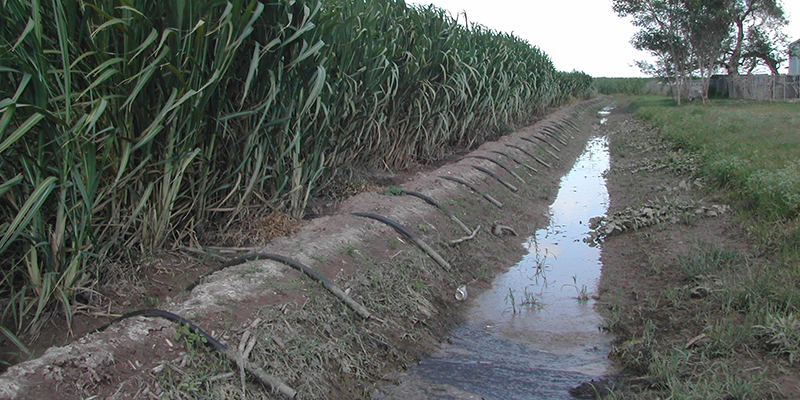A team of researchers representing various Texas A&M entities and the New Mexico Water Resources Institute has been awarded a $5 million four-year grant from the U.S. Department of Agriculture’s National Institute of Food and Agriculture to address water challenges in the Rio Grande Basin.
The grant will help researchers from the Texas Water Resources Institute (TWRI), Texas A&M AgriLife Research, the Texas A&M AgriLife Extension Service and the New Mexico Water Resources Institute investigate alternative water sources, new crops, management practices and improved water conservation to sustain agriculture in the basin.
The project, “Diversifying the Water Portfolio for Agriculture in the Rio Grande Basin,” will be led by TWRI director Dr. John C. Tracy. The project will be funded as part of the USDA-NIFA Agriculture and Food Research Initiative, authorized by the 2014 Farm Bill.
“The water resources within the Rio Grande Basin, plus the societies, economies, species and ecosystems that depend on them, are seriously threatened by drought, climate change and rapid population growth,” Tracy said. “Through this project, we hope to diversify the sources and conditions of water to sustain agricultural production in the basin. Our goal is to provide more stable and sustainable agricultural production while enhancing water-use efficacy to improve economic and ecosystem conditions.”
The project will include co-principal investigators Dr. Sam Fernald, director of the New Mexico Water Resources Institute at New Mexico State University; Dr. Girisha Ganjegunte, associate professor, Texas A&M AgriLife Research Center at El Paso; Dr. Bruce McCarl, Texas A&M professor of agricultural economics; Dr. Raghavan Srinivasan, professor, ecosystem science and management, Spatial Sciences Laboratory; and Dr. Kevin Wagner, TWRI deputy director.
Fernald said Texas A&M and New Mexico State University have a significant and successful history of collaborating with each other.
“The strategic partnerships among the project team from these two land-grant institutions and with other initiatives and key stakeholders in the region will create a platform from which we can build many successful projects, proposals and partnerships,” he said.
Tracy said a team of more than 16 collaborators will be involved in the project. “Each of these members will fulfill an important role in their area of research or extension expertise,” he said.
Ganjegunte said agriculture is a valuable component of the basin’s economy, generating $1 billion annually.
“Since agriculture withdraws 80 percent of the freshwater resources in the area, one of the major objectives of this project is to develop alternative water sources and appropriate salinity management practices to ensure long-term viability of irrigated agriculture,” he said.
Ganjegunte said the researchers will identify the most suitable crops and cultivars, plus a diversified cropping system based on salt tolerance, adaptability to the climate and economic importance.
McCarl said the project will employ models that link the basin’s hydrologic and economic systems to examine how changes in water management practices would impact water availability and environmental conditions.
“This will allow for investigation of different water allocations schemes and the variables in water use throughout the entire spectrum,” he said. “We’ll look at variables such as how changes in climate – such as dry, moderate and wet conditions – will impact water availability and agricultural production. We hope to help stakeholders identify the most desirable alternatives to current water management practices throughout the Rio Grande Basin.”
Srinivasan said the project will include the integration of the Soil and Water Assessment Tool, or SWAT, and RIVERSIM — a river simulation web application framework for selecting and preparing data for input into river models — in order to assess the hydrology and availability of the basin’s water resources.
“We’ll be working to improve the understanding of water availability and how to best to use the available water resources,” he said. “Agricultural producers in the basin have limited water access and availability, so we hope to assess this availability and help find out what’s happening in both the landscape and the basin itself. Linking the SWAT and RIVERSIM models will help us get a more complete picture of both access and availability.”
Wagner said the project will use outreach, demonstration, teaching and other tools to facilitate efficient use of all available water resources for regional stakeholders.
“This project will produce a lot of useful data on the use of alternative water sources, such as higher salinity water and reused water, and how to manage that water to produce a crop,” he said. “There’s also a water conservation component. AgriLife Extension will work with extension personnel in New Mexico to involve and educate stakeholders along the Rio Grande as to the results and practical applications of this research.”
“The results will serve as a model for basins around the world facing similar challenges,” he said.
For more information, contact Tracy at john.tracy@ag.tamu.edu.

